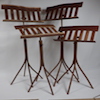Guys,
I've painted myself into a corner and I need a hand. I'm mocking-up a butcher block top now. It's going to be 3 1/2" thick and 20" wide and 30" long. After I do a 10" wide mockup in pine, I'll do the final 20" wide top in maple.
This morning I realized that none of my tools will handle that thickness/width combination. And I'm searching for a safe way to square this top.
The details.......
My CMS will handle widths up to about 6" wide at the thickness Im talking about. That means make 3 sections and hope they alugn pefectly in the final glue up. My contractor saw has a darn good sled, but Im reluctant to make a cut that deep (dangerous?) plus I have to remove the blade stiffener to get that deep in the first place.
So I when went to buy the maple this morning, I asked my supplier if I could pay them to square it up after I build the final maple top. He said they got rid of their big industrial size radial arm saw because it was missing a number of guards, etc and someone had gotten a minor injury.
My next thought was "hire a cabinet shop" to square it up. But what do I do if I cant find one willing/able to do it? I mean, if my lumberyard got rid of their big saw, are others likely to have one? Dunno.
I looked at track saws, but the Makita doesnt look like it will cut that thick either. (Maybe I missed something?)
I'm not sure I'm good enough with handsaws or planes to square it. I toyed with using a big ROS or even an air-driven auto body sander. But those seem like last resorts.
Am I missing something obvious? I've decided I really do like the look of that 3 1/2" thick top. But if I can't find an answer, I'll have to go to something thinner, as some of you suggested last weekend.
Thank you,
Fred




 Reply With Quote
Reply With Quote





